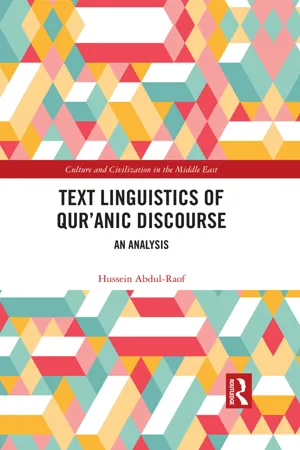
- 368 pages
- English
- ePUB (mobile friendly)
- Available on iOS & Android
About This Book
Text Linguistics of Qur'anic Discourse is an in-depth investigation of the fabric of Qur'anic Discourse. It unravels the texture of the macro Qur'anic text; its cohesion and coherence systems; the notions of intertextuality, semantic relatedness, and thematic sequentiality; the macro textual features of ellipsis, repetition, and argumentation structure; and the contextual, co-textual, grammatical, and semantic factors involved in the macro Qur'anic text. This book is a valuable and methodologically consistent learning and teaching academic resource for universities worldwide in this intriguing new discipline. Through its methodologically coherent discussion and in-depth analysis that is hinged upon modern European text linguistics, Text Linguistics of Qur'anic Discourse provides an insight into the newly established discipline of text linguistics, and explores the different layers of the macro Qur'anic text as an academic requirement.
Frequently asked questions
Information
1
Text linguistics
1.1 Introduction
1.2 What is text linguistics?
1.3 Major notions in text linguistics
1.3.1 Text
- It is any passage, spoken or written, of whatever length, that forms a unified whole.
- It is a unit of language in use.
- It is any form of a communicative or meaningful event.
- It is not a grammatical unit like a sentence or a clause.
- It is a semantic unit (a unit of meaning).
- It does not consist of sentences but is realized by (encoded in) sentences.
- It is not defined by its size.
- It has texture which distinguishes it from something that is not a text.
- It is coherent and cohesive.
- A text has cohesive properties through which it can be analyzed, and that some items within the text function cohesively (Halliday and Hasan 1976:3–4).
- A text is a communicative occurrence which should meet seven standards of textuality: cohesion, coherence, intentionality, acceptability, informativity, situationality, and intertextuality (Beaugrande and Dressler 1981:3).
- Texts are seen as vehicles for the expression of a range of socio-cultural meanings (Hatim and Munday 2004:86).
- A text must be relevant to other texts in the same discourse and not just to participants’ intentions and to the situational setting (Beaugrande and Dressler 1981:188).
1.3.1.1 Text illocutionary force
- the minimum use of allusion (hidden meaning),
- the minimum use of structural and semantic ambiguity,
- the minimum use of amphigouri (periphrasis) and bombast (pointless, redundant discourse – kalām ajwaf malī’ bil-ḥashu),
- the minimum use of catachresis (excessive allegory – al-tacassuf al-majāzi),
- the minimum use of complete non-relatedness (lack of coherence – kamāl al-inqiṭāc) whose antonym is complete relatedness (consonance – kamāl al-ittiṣāl),
- the minimum use of coding (al-ilghāz), i.e., blinding when using metonymy,
- the minimum use of complex assonance (al-sajcal-mucaqqad),
- the minimum use of implicatures,
- the words employed should have explicatures (macānī wāḍiḥah),
- the minimum use of inkhorn expressions (al-fāẓ gharībah),
- the minimum use of lexical oddity (gharābat al-alfāẓ),
- the use of elegance of discourse (ḥ usn al-kalām),
- the use of elegance of introduction (ḥ usn al-istihlāl),
- compatibility between the register of discourse and the psychological state of the audience,
- the use of grammatical, morphological, semantic, and stylistic congruity,
- a pragmatically effective and appropriate text should enjoy stylistic purity (al-jazālah), should employ a sublime style (islūb rafic), and should avoid verbosity (iṭnāb),
- a pragmatically effective and appropriate text should be decorated by embellishments (cilm al-badīc) and figures of speech (cilm al-bayān) to promote the text’s figure of thought (al-ṣ ūrah al-bayāniyyah lil-naṣ ṣ), and
- the illocutionary force of the text can be enhanced through the employment of foregrounding a sentence constituent and bringing it into a prominent perspective.
1.3.1.2 Text receiver
- the use of minimum allusion (hidden meaning),
- the use of minimum structural and semantic ambiguity,
- the use of minimum amphigouri (pointless discourse).
- disbelievers (kāfirūn): This is a major category of Qur’anic text receivers. They can be sub-classified into:
- the polytheists (al-mushrikūn): This category of Qur’anic text receivers are deniers (munkirūn) of the Qur’anic intended message, namely, monotheism and Muḥammad’s prophethood. The polytheists represent idol worshippers, i.e., believers in different gods. However, they believe in the hereafter. Example: (wajadnā ābā’anālaha cābidīn… – We found our fathers worshippers of them (idols), Q21:53).
- the heretics (al-mulḥidūn): This category of Qur’anic text receivers are deniers (munkirūn) of the Qur’anic intended message, namely, monotheism, Muḥammad’s prophethood, eschatology, and reward and punishment. The heretics are not idol worshippers, i.e., they are disbelievers in any god. Example: (mā hiya illā ḥayatunā al-dunyā namūtu wanaḥyā wamā yuhlikunā illā aldahr – This is not but our worldly life. We die and live and nothing destroys us except time, Q45:24).
- the Jews (al-yahūd, banū isrā’īl): This category of Qur’anic text receivers are deniers (munkir) of the Qur’anic intended message of monotheism and Muḥammad’s prophethood. However, they are believers in...
Table of contents
- Cover
- Half Title
- Series Page
- Title
- Copyright
- Dedication
- Contents
- Preface
- Acknowledgements
- Arabic transliteration system
- Introduction
- 1 Text linguistics
- 2 Qur’anic macro text
- 3 Argumentation structure in Qur’anic discourse
- 4 Ellipsis in Qur’anic discourse
- 5 Coherence in Qur’anic discourse
- 6 Cohesion in Qur’anic discourse
- 7 Linguistic inimitability of Qur’anic discourse
- 8 General observations on Qur’anic text linguistics
- Bibliography
- Index